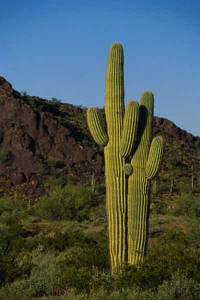There is was on a 15 hour drive with the family going through Nevada. Wife a sleep, one year old likely screaming because he was sick and teething, and two daughters arguing about which cacti can be used as water sources; they are 3 and 5 so it was not a very intellectual discussion. However it did make me curious because I’ve heard that at least the fruit of most cacti is edible; what about the rest? I read a number of articles from reputable websites and was surprised by what I found. I’ve opted to post one of the articles in its entirety below as it was very well written and had all the info I was finding in varied forms from other sites; giving full credit to the original author. The link to the original article is at the bottom. I’ll do a little research on edible cactus fruit, but that’s for another day.
Jon
Cactus water will make you sick
June 5, 2013 Jonathan DuHamel
cactusADI recently had a story about six men lost in the desert who claimed they survived by drinking water from cacti. The story reported that the men became sick.
That’s what happens if you drink water stored in a cactus. You can get some moisture from cactus fruit and all cactus fruit is edible, though all do not taste good.
The Seri Indians sometimes used the Fishhook barrel (Ferocactus wislizeni) for emergency water. However, drinking the juice on an empty stomach often caused diarrhea and that will further dehydrate you. Some Seri report pain in their bones if they walk a long distance after drinking the juice. The Seri called the Coville barrel (Ferocactus emoryi), “barrel that kills” because eating the flesh of the cactus causes nausea, diarrhea, and temporary paralysis.
Why is the water in a cactus not generally potable? Moisture within the pulp of a cactus is very acidic and many cacti contain toxic alkaloids.
The moisture is acidic because of the way many succulents, including cacti, carry on photosynthesis, the process by which carbon dioxide and water are turned into carbohydrates.
Most plants have their pores open during the day to take in carbon dioxide, and use sunlight as a catalyst for the reaction: Carbon dioxide + water becomes sugar + oxygen. But in the desert, plants with pores open during the hot days, lose much water through evapotranspiration.
So, succulents use a modified version of photosynthesis called CAM (Crassulacean Acid Metabolism). CAM plants open their stomates only at night when it is cooler so there is less water loss. Because there is no sunlight to act as a catalyst, carbon dioxide is stored as an organic acid, principally Malic Acid (C4H6O5). Carbon dioxide is gradually released from the acid during the next day. CAM plants use about one-tenth the water to produce each unit of carbohydrate compared to standard photosynthesis. The price: a much slower growth rate.
Many plants contain malic acid, but usually in lesser quantities than found in cacti. Also cooking generally destroys the acid.
Besides malic acid, succulents produce Oxalic Acid (C2H2O4), which is toxic, as another product of photosynthesis. “Its chief function seems to be sequestering metals, principally calcium. Calcium oxalates often occur as crystalline minerals within the cactus pulp. Their function seems to be aiding structural integrity and enzymatic processes. In fact two crystalline calcium oxalate minerals have been identified in all cacti tested: CaC2O4.2H2O (weddellite) and CaC2O4.H2O (whewellite).” [Source: Plant Physiology, February 2002, Vol. 128, pp. 707-713.] Oxalates are also formed with heavy metals such as copper, perhaps to reduce toxicity to the plant.
Oxalic acid is toxic to humans because it combines with calcium in our bodies to produce calcium oxalates which clog up our kidneys.
What about Prickly Pear pads we sometimes see in grocery stories or on the menu of Mexican restaurants? What you see are generally young spring pads which naturally contain less oxalic acid. Cooking leaches out the acid. In an emergency you can eat the young pads raw. And there are some spineless cultivars that naturally contain little oxalic acid which can also be eaten raw. These were developed mainly as cattle feed.
If you are lost in the desert without water, drinking cactus water may save your life, but there is a delicate balance, too much will make you sick and cause additional dehydration, and that will kill you. The bottom line is you really should not get a drink from a cactus in spite of what you may have seen in old cowboy movies.
Copyrighted by Jonathan DuHamel. Reprint is permitted provided that credit of authorship is provided and linked back to the source.



Leave a Reply